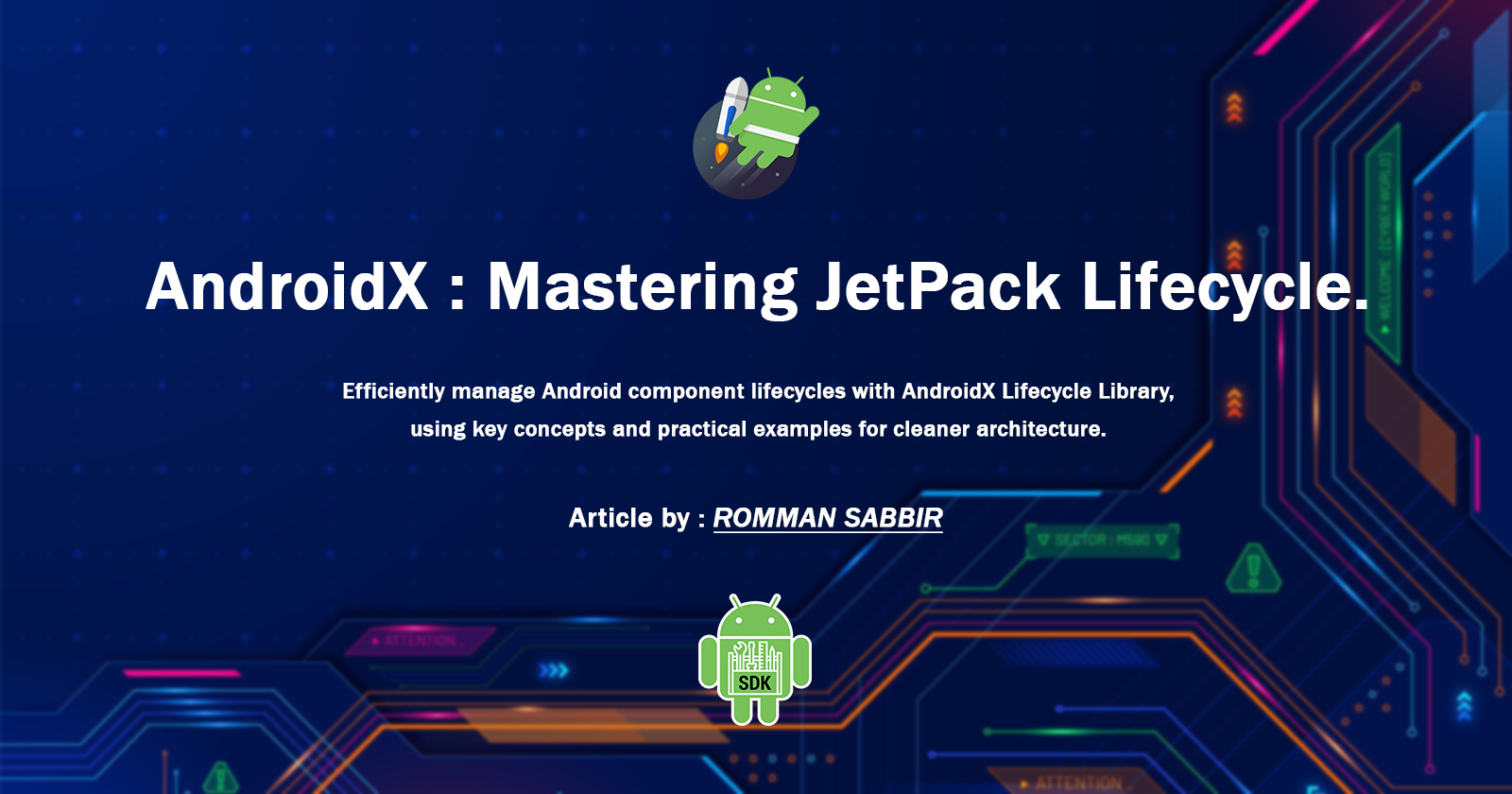AndroidX : Mastering JetPack Lifecycle.
 Romman Sabbir
Romman Sabbir
The AndroidX Lifecycle library is part of Jetpack and helps manage the lifecycle of Android components like activities and fragments. It simplifies handling lifecycle events and makes our app's components lifecycle-aware.
Key Components and Concepts
LifecycleOwner: An interface that indicates an object has an Android lifecycle. Activities and fragments are the primary implementations.
LifecycleObserver: An interface for classes that want to observe the lifecycle of
LifecycleOwnercomponents. Observer classes use annotations like@OnLifecycleEventto indicate which lifecycle events they are interested in.Lifecycle: A class that holds information about the lifecycle state of a component (like an activity or fragment). It can be used to query the current state and add/remove observers.
Lifecycle.Event: Enumerates different lifecycle events (e.g.,
ON_CREATE,ON_START,ON_RESUME, etc.).
Lifecycle.State
Lifecycle.State: Enumerates different lifecycle states:
INITIALIZED: The initial state, not yet created.
CREATED: The state after
onCreateis called.STARTED: The state after
onStartis called.RESUMED: The state after
onResumeis called.DESTROYED: The state after
onDestroyis called.
Lifecycle Callbacks
Here are the primary lifecycle callbacks:
ON_CREATE: Called when the
LifecycleOwneris created.ON_START: Called when the
LifecycleOwnerbecomes visible to the user.ON_RESUME: Called when the
LifecycleOwnerstarts interacting with the user.ON_PAUSE: Called when the
LifecycleOwnerstops interacting with the user.ON_STOP: Called when the
LifecycleOwneris no longer visible to the user.ON_DESTROY: Called when the
LifecycleOwneris destroyed.
How It Works
LifecycleOwner: An
ActivityorFragmentimplements theLifecycleOwnerinterface. It manages aLifecycleRegistryobject, which tracks the lifecycle state and events.LifecycleRegistry: This is an implementation of
Lifecycleused byLifecycleOwnerto handle lifecycle events and states.LifecycleObserver: You can create classes that implement
LifecycleObserverto observe lifecycle changes. These classes can define methods annotated with@OnLifecycleEventto receive lifecycle callbacks.
Implementing LifecycleOwner
The LifecycleOwner interface is implemented in the ComponentActivity class, which is the base class for activities in the AndroidX library. ComponentActivity extends Activity and implements LifecycleOwner.
Here's a simplified view of how LifecycleOwner is implemented in ComponentActivity:
LifecycleOwner Interface
public interface LifecycleOwner {
Lifecycle getLifecycle();
}
ComponentActivity Implementation
In ComponentActivity, the lifecycle is managed by a LifecycleRegistry object:
public class ComponentActivity extends Activity implements LifecycleOwner {
private final LifecycleRegistry mLifecycleRegistry = new LifecycleRegistry(this);
@Override
public Lifecycle getLifecycle() {
return mLifecycleRegistry;
}
@Override
protected void onCreate(@Nullable Bundle savedInstanceState) {
super.onCreate(savedInstanceState);
mLifecycleRegistry.handleLifecycleEvent(Lifecycle.Event.ON_CREATE);
}
@Override
protected void onStart() {
super.onStart();
mLifecycleRegistry.handleLifecycleEvent(Lifecycle.Event.ON_START);
}
@Override
protected void onResume() {
super.onResume();
mLifecycleRegistry.handleLifecycleEvent(Lifecycle.Event.ON_RESUME);
}
@Override
protected void onPause() {
super.onPause();
mLifecycleRegistry.handleLifecycleEvent(Lifecycle.Event.ON_PAUSE);
}
@Override
protected void onStop() {
super.onStop();
mLifecycleRegistry.handleLifecycleEvent(Lifecycle.Event.ON_STOP);
}
@Override
protected void onDestroy() {
super.onDestroy();
mLifecycleRegistry.handleLifecycleEvent(Lifecycle.Event.ON_DESTROY);
}
}
LifecycleRegistry
LifecycleRegistry is a key part of the AndroidX Lifecycle library. It manages the lifecycle events of LifecycleOwner objects like Activity or Fragment. It keeps a list of observers who are informed about lifecycle changes and tracks the current lifecycle state.
Key Features of LifecycleRegistry
Lifecycle Management: It tracks the current state of the lifecycle and transitions through various lifecycle states.
Observer Notifications: Notifies registered
LifecycleObserverinstances of lifecycle events.State Handling: Handles the progression of lifecycle states and events in a controlled manner.
Internal Implementation
Here's a simplified version of how LifecycleRegistry works internally:
public class LifecycleRegistry extends Lifecycle {
private State mState;
private final WeakReference<LifecycleOwner> mLifecycleOwner;
private final FastSafeIterableMap<LifecycleObserver, ObserverWithState> mObserverMap = new FastSafeIterableMap<>();
public LifecycleRegistry(@NonNull LifecycleOwner provider) {
mLifecycleOwner = new WeakReference<>(provider);
mState = State.INITIALIZED;
}
@Override
public void addObserver(@NonNull LifecycleObserver observer) {
ObserverWithState statefulObserver = new ObserverWithState(observer, mState);
mObserverMap.putIfAbsent(observer, statefulObserver);
}
@Override
public void removeObserver(@NonNull LifecycleObserver observer) {
mObserverMap.remove(observer);
}
@Override
public State getCurrentState() {
return mState;
}
public void handleLifecycleEvent(@NonNull Event event) {
mState = event.getTargetState();
for (Entry<LifecycleObserver, ObserverWithState> entry : mObserverMap) {
entry.getValue().dispatchEvent(mLifecycleOwner.get(), event);
}
}
static class ObserverWithState {
State mState;
LifecycleObserver mObserver;
ObserverWithState(LifecycleObserver observer, State initialState) {
mObserver = observer;
mState = initialState;
}
void dispatchEvent(LifecycleOwner owner, Event event) {
// Dispatch event to the observer
}
}
}
Explanation
State Management:
mStaterepresents the current state of the lifecycle (e.g.,CREATED,STARTED).The
handleLifecycleEventmethod updates this state based on lifecycle events.
Observer Management:
mObserverMapstores the observers along with their respective states.addObserverandremoveObservermethods manage the observers, adding or removing them frommObserverMap.
Lifecycle Event Handling:
handleLifecycleEventmethod is called whenever a lifecycle event occurs. It:Updates the current state.
Notifies each observer by calling
dispatchEventon theObserverWithStateinstance.
WeakReference:
mLifecycleOwneris held as aWeakReferenceto prevent memory leaks by allowing theLifecycleOwnerto be garbage collected when it is no longer in use.
ObserverWithState Class:
Holds the state and the observer itself.
dispatchEventmethod is responsible for invoking the appropriate callback methods on the observer when lifecycle events occur.
Example
Step 1: Add Dependencies
Add the necessary dependencies in our build.gradle file:
dependencies {
implementation "androidx.lifecycle:lifecycle-runtime-ktx:2.5.1"
implementation "androidx.lifecycle:lifecycle-extensions:2.2.0"
}
Step 2: Create a LifecycleObserver
Create a class that implements LifecycleObserver and define methods to handle lifecycle events:
import androidx.lifecycle.Lifecycle
import androidx.lifecycle.LifecycleObserver
import androidx.lifecycle.OnLifecycleEvent
class MyObserver : LifecycleObserver {
@OnLifecycleEvent(Lifecycle.Event.ON_CREATE)
fun onCreateEvent() {
println("ON_CREATE event")
}
@OnLifecycleEvent(Lifecycle.Event.ON_START)
fun onStartEvent() {
println("ON_START event")
}
@OnLifecycleEvent(Lifecycle.Event.ON_RESUME)
fun onResumeEvent() {
println("ON_RESUME event")
}
@OnLifecycleEvent(Lifecycle.Event.ON_PAUSE)
fun onPauseEvent() {
println("ON_PAUSE event")
}
@OnLifecycleEvent(Lifecycle.Event.ON_STOP)
fun onStopEvent() {
println("ON_STOP event")
}
@OnLifecycleEvent(Lifecycle.Event.ON_DESTROY)
fun onDestroyEvent() {
println("ON_DESTROY event")
}
}
Step 3: Attach the Observer to a LifecycleOwner
Attach our LifecycleObserver to a LifecycleOwner (e.g., an Activity or Fragment):
import android.os.Bundle
import androidx.appcompat.app.AppCompatActivity
class MainActivity : AppCompatActivity() {
private lateinit var myObserver: MyObserver
override fun onCreate(savedInstanceState: Bundle?) {
super.onCreate(savedInstanceState)
setContentView(R.layout.activity_main)
myObserver = MyObserver()
lifecycle.addObserver(myObserver)
}
}
Advantages
Separation of Concerns: Move lifecycle-dependent code out of
ActivityorFragmentclasses into separate, reusable components.Simplified Lifecycle Management: Lifecycle-aware components automatically handle lifecycle events and state transitions, reducing boilerplate code.
Cleaner Architecture: Promotes a cleaner architecture by decoupling lifecycle-related logic from UI logic.
Summary
LifecycleOwner: Interface that any class with a lifecycle (like
ActivityorFragment) should implement. It provides agetLifecyclemethod.LifecycleRegistry: A concrete implementation of
Lifecycleused internally byLifecycleOwnerto manage the lifecycle events and states.ComponentActivity: Extends
Activityand implementsLifecycleOwner. It initializes aLifecycleRegistryand handles lifecycle events.LifecycleObserver: An interface for classes that want to observe lifecycle changes. Methods in these classes are annotated with
@OnLifecycleEvent.
Conclusion
The AndroidX Lifecycle library, part of Jetpack, provides a robust framework for managing the lifecycle of Android components like activities and fragments. By implementing the LifecycleOwner interface and using the LifecycleRegistry, ComponentActivity and other components can efficiently handle lifecycle events. Observers implementing LifecycleObserver can be easily attached to monitor these events, promoting a clean separation of concerns, simplifying lifecycle management, and enhancing the overall architecture of our application. This approach reduces boilerplate code and makes our application more maintainable and scalable.
That's it for today. Happy Coding...
Subscribe to my newsletter
Read articles from Romman Sabbir directly inside your inbox. Subscribe to the newsletter, and don't miss out.
Written by

Romman Sabbir
Romman Sabbir
Senior Android Engineer from Bangladesh. Love to contribute in Open-Source. Indie Music Producer.